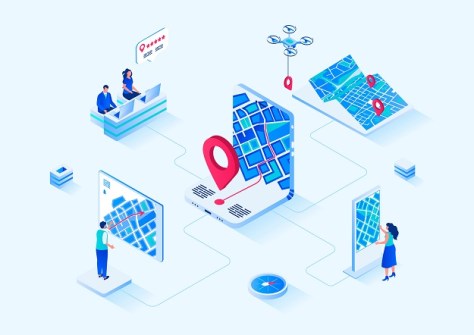
Envisioning human-computer interaction with the latest geoinformatic and cartographic devices.
By Pyry Kettunen, Petr Kubíček, Hua Liao, Tumasch Reichenbacher
The explosion of geospatial data the world has experienced since the start of the Internet and the increasing accessibility of high spatial and temporal resolution satellite imagery, means that understanding how humans and computers can cooperate and collaborate in an era of big geospatial data is becoming ever more important.
New and improved technologies such as AI and immersive environments raise new questions about how human cognition informs interaction with computers. Pervasive computing also means that many people have a digital map in their pocket, meaning they are relying on maps more than ever to support many varied kinds of tasks in all sorts of use situations and contexts.
The vision of the International Cartographic Association (ICA)’s Commission on Cognitive Issues in Geographic Information Visualization (CogVis) is to use what we know about visual perception and cognition to support the design of successful static maps, dynamic and interactive maps, and geovisual analytics displays and systems.
When you were building a map, did you ever struggle to decide how to symbolise your data? Our commission undertakes research that can help you make these decisions and inform how geospatial systems designers build systems that can help the system’s users to make spatio-temporal decisions effectively and efficiently.
We do this through projects that build an evidence base about when, how, why and for whom human inference, analytical reasoning and problem solving, and spatio-temporal decision-making is successful. This fundamental knowledge informs the development of design principles and guidelines that can support a human-centred approach to visualising geospatial information.
Our commission often collaborates with other groups within the ICA and with our sister societies, such as the International Society for Photogrammetry and Remote Sensing, the Open Geospatial Consortium and national geospatial societies in member countries to investigate topics of mutual interest and to produce research and practical outputs.
Some recent events and workshops have investigated themes such as:
- cognitive issues involved in the use of maps designed for mobile devices;
- how to build an evidence base for deciding how to choose symbols for new types of map displays such as in immersive environments (e.g. augmented or virtual reality);
- which opportunities AI technologies might provide for helping us to understand how people use maps or how to personalise maps by adapting them to a new situation or new user.
Some of our publications are freely available through links on our website. A recent issue of the International Journal of Cartography that our Commission helped to produce includes some contributions that practitioners might find useful for informing their work. For example, one of the papers summarises the results of many scientific studies that tried to answer the question of how small map symbols can be before they are no longer legible. Another article explored how eye tracking and machine learning might be combined to create gaze-aware interactive maps that use the reader’s eyes to control the map.
Other contributions in the journal explore topics such as levels of detail in augmented reality, how people move in virtual indoor environments, and designing common interactions (e.g., zooming) for multiscale maps. (Note: If any of the articles aren’t open access, you can contact the author and ask for a free copy.)
Want to learn more and get involved?
Currently, the commission has about 230 members representing 34 countries. You can become a member, receive the topical emails from our mailing list, and see additional details at the commission’s website. Our website includes links to recent publications and videos of workshop presentations. For example, you can see the videos from the lightning talks at our recent MapAI workshop, which took place in Stellenbosch South Africa before the most recent International Cartographic Conference.
Another good opportunity to get involved is the participation in the various workshops and events (co)organised by the CogVis commission. These events are held in different regions of the world and are open to anyone who is interested. You can see the upcoming schedule on the commission website. Moreover, the commission is organising sessions dedicated to cognitive issues in cartography at the bi-annual International Cartographic Conference (ICC). During these conferences the commission also holds meetings to discuss the commission plans and activities.
Dr Pyry Kettunen is Research Manager at the Finnish Geospatial Research Institute FGI, NLS. Dr Petr Kubíček is Professor in the Masaryk University, Brno. Dr Hua Liao is Associate Professor at the School of Geographic Sciences, Hunan Normal University in Changsha, China. Dr Tumasch Reichenbacher is Group Leader at the Department of Geography, University of Zürich. This group of Co-Chairs wants to acknowledge all the previous Chairs and Vice-Chairs for the work they have done to bring the Commission to the present day.







